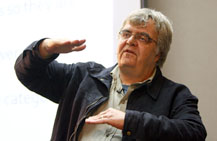 |
|
Mike Schüssler, economist
Photo: Hannes Pieterse
15 November 2012
|
Census 2011 contains good statistics but these are overshadowed by vuvuzela announcements and a selective approach, economist Mike Schüssler said at a presentation at the UFS.
“Why highlight one inequality and not another success factor? Is Government that negative about itself?” Mr Schüssler, owner of Economist.co.za, asked.
“Why is all the good news such as home ownership, water, lights, cars, cellphones, etc. put on the back burner? For example, we have more rooms than people in our primary residence. Data shows that a third of Africans have a second home. Why are some statistics that are racially based not made available, e.g. orphans? So are “bad” statistics not always presented?”
He highlighted statistics that did not get the necessary attention in the media. One such statistic is that black South Africans earn 46% of all income compared to 39% of whites. The census also showed that black South Africans fully own nearly ten times the amount of houses that whites do. Another statistic is that black South Africans are the only population group to have a younger median age. “This is against worldwide trends and in all likelihood has to do with AIDS. It is killing black South Africans more than other race groups.”
Mr Schüssler also gave insight into education. He said education does count when earnings are taken into account. “I could easily say that the average degree earns nearly five times more than a matric and the average matric earns twice the pay of a grade 11.”
He also mentioned that people lie in surveys. On the expenditure side he said, “People apparently do not admit that they gamble or drink or smoke when asked. They also do not eat out but when looking at industry and sector sales, this is exposed and the CPI is, for example, reweighted. They forget their food expenditure and brag about their cars. They seemingly spend massively on houses but little on maintenance. They spend more than they earn.”
“On income, the lie is that people forget or do not know the difference between gross and net salaries. People forget garnishee orders, loan repayments and certainly do not have an idea what companies pay on their behalf to pensions and medical aid. People want to keep getting social grants so they are more motivated to forget income. People are scared of taxes too so they lower income when asked. They spend more than they earn in many categories.”
On household assets Mr Schüssler said South Africans are asset rich but income poor. Over 8,3 million black African families stay in brick or concrete houses out of a total of 11,2 million total. About 4,9 million black families own their own home fully while only 502 000 whites do (fully paid off or nearly ten times more black families own their own homes fully). Just over 880 000 black South Africans are paying off their homes while 518 000 white families are.
Other interesting statistics are that 13,2 million people work, 22,5 million have bank accounts, 19,6 million have credit records. Thirty percent of households have cars, 90% of households have cellphones and 80% of households have TVs.